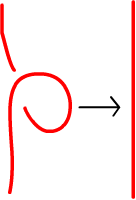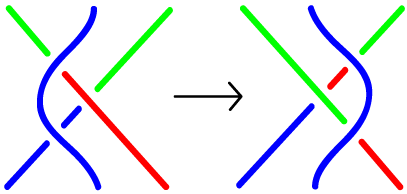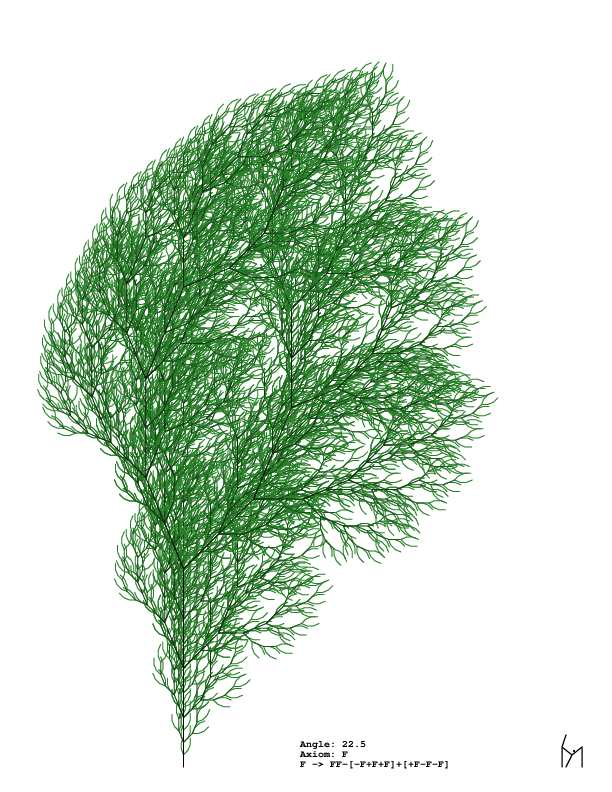- Our quiz on Thursday will involve knot identification, distinguishing them via the Reidemeister moves and tricolorability.
- On Monday I'd like you to provide me with a one paragraph description of your project and a one paragraph description of your logo; I want to make sure that everyone has something to share on the following Monday, April 28.
- We learned about the Reidemeister moves, and how to use them to
show that two pictures of knots are the same knot.
That's one way! There is another, which we'll see today.
- In particular, we saw that while there are two different versions of the trefoil knot (left and right-handed), and two different versions of the Mobius strip (left and right-handed), you can transform a "left-handed" figure-eight knot into a "right-handed" one -- or vice versa. Hence there is only one kind of figure-eight knot.
- A little review, and a preview of what's ahead: trying to
distinguish this collection of knots (and links, too!).
-
The figure-eight
knot has four crossings, as does Solomon's "knot" -- but
Solomon's "knot" a link, not a knot. This is the first
(interesting) instance of a knot and link with the same
(minimal) number of crossings.
But we can easily figure out which is which, because the knot is a single continuous piece of material, whereas the link is two separate pieces of material.
- We know that there are two distinct 5-crossing knots
(we can see them in Rolfsen Knot Table)
- The cinquefoil knot, which has R5 symmetry; and
- The other five-crossing knot \(5_2\), which is actually known (somewhat confusingly) as the 3-twist knot (making it sounds like a trefoil).
- How can we tell them apart? Are they really different? For that we need to study knot equivalence, and our primary tool, the Reidemeister moves.
-
The figure-eight
knot has four crossings, as does Solomon's "knot" -- but
Solomon's "knot" a link, not a knot. This is the first
(interesting) instance of a knot and link with the same
(minimal) number of crossings.
- How do we show that two knot projections ("squiggles") are the
same knot ("knot
equivalence")? That's the job of the Reidemeister
moves.
- Let's start with this short video, Using Reidemeister
Moves
- What are the Reidemeister moves?
- Tools for showing that two projections (pictures) of knots really show the same knot.
- Names of the moves reflect the number of
strands involved. A Strand is a
piece of a knot picture that
goes from undercrossing to
undercrossing, with only
overcrossings inbetween.
It's all about overs and unders!
- Reidemeister moves preserve the knot -- they don't change the knot. We're not cutting -- we're just going to shove parts of the knot around.
-
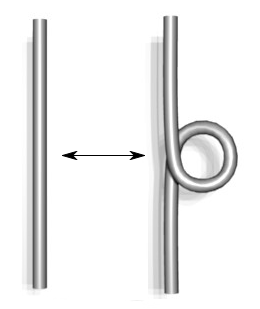
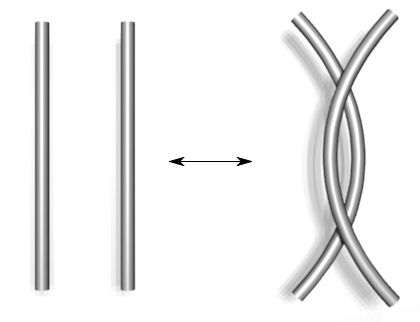
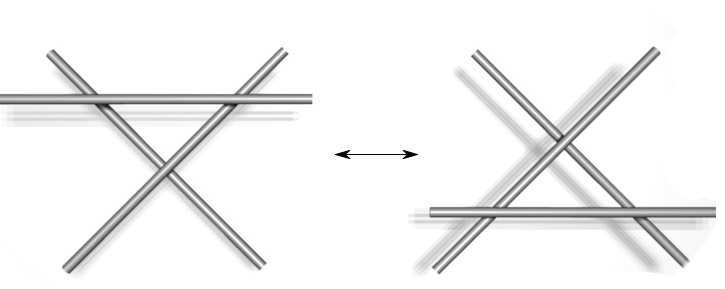
Type I Type II Type III
- Here's a
summary of the moves.
The third images on that page stems from this picture from a recent Science issue:

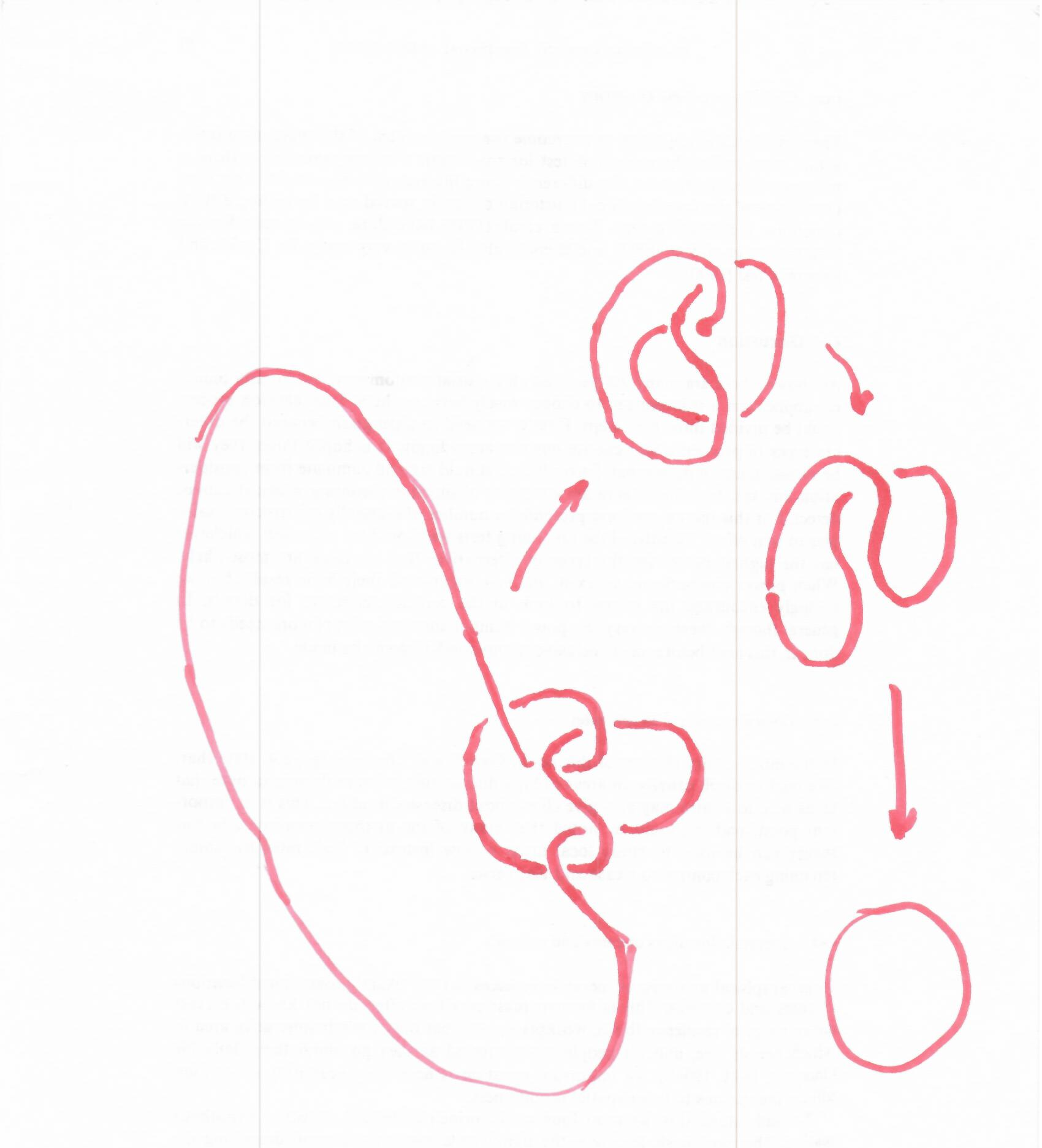
In order to consider the picture on the left a knot, we have to know what its ends are doing. In the figure at right, I assumed that they are just connecting to each other in the simplest way.
The succession of steps then go on to show that the knot is actually an unknot! That's good news for the hyperbusy people!
- Using the Reidemeister moves
- to turn a projection of an unknot into another
more complicated appearing unknot:

Here's another picture of an unknot, which could trick you -- but knowing the R1 move saves you:

We'll just try a few with a string, to see what we can learn.
- Now let's use these three moves to create equivalent
versions of the trefoil knot, but using each of the three
Reidemeister moves.
- A figure-eight knot is equivalent to its mirror reflection (a trefoil knot is not equivalent to its mirror!)
- Turning a more complicated appearing unknot into a simple circle unknot. (Here it is as a powerpoint presentation.)
- to turn a projection of an unknot into another
more complicated appearing unknot:
- Reidemeister moves and Tricolorability
- Tricolorability:
"A knot is tricolorable if each strand of the
knot diagram can be colored one of three
colors, subject to the following rules:
- At least two colors must be used,
- at most three colors are used, and
- at each crossing, the three incident strands are either all the same color or all different colors.
- Tricolorability is preserved by Reidemeister moves:
Reidemeister Move I is tricolorable. Reidemeister Move II is tricolorable. Reidemeister Move III is tricolorable. - Therefore, if the projection of one knot is
tricolorable and the other isn't, they're different
knots (because we can't get from one to the other via
Reidemeister moves).
- Theorem: there are at least two different knots.
The unknot is not tricolorable ("At least two colors must be used") The trefoil knot is tricolorable: The figure-eight knot is not tricolorable (it requires four colors): "The figure-eight knot is not tricolorable. In the diagram shown, it has four strands with each pair of strands meeting at some crossing. If three of the strands had the same color, then all strands would be forced to be the same color. Otherwise each of these four strands must have a distinct color. Since tricolorability is a knot invariant, none of its other diagrams can be tricolored either." (source) 


- Danger: be careful what you conclude:
- Links can be tricolorable, too -- for example, the unlink is
tricolorable! (That's just two circles, one lying on top of
the other, as in Borromean rings.)
- many knots are tricolorable -- in fact, infinitely
many! -- so being tricolorable doesn't mean that
your knot is the trefoil knot -- but it does mean that
your knot is not the unknot, for example.
So, for example: if you've got your picture of a knot down to three crossings, and it's not tricolorable, then it's the unknot.
- And among knots and links with five crossings or fewer, only
the trefoil and the unlink are tricolorable.
- Links can be tricolorable, too -- for example, the unlink is
tricolorable! (That's just two circles, one lying on top of
the other, as in Borromean rings.)
- Here's a
gallery of all knots up to seven crossings. We
already know about those with five or fewer crossings.
Which of the 6- and 7-knots are tricolorable? (There are three.)
- Then we'll consider "A Knotty Tale", and try to determine all the knots (and links).
- Tricolorability:
"A knot is tricolorable if each strand of the
knot diagram can be colored one of three
colors, subject to the following rules:
- Let's start with this short video, Using Reidemeister
Moves
